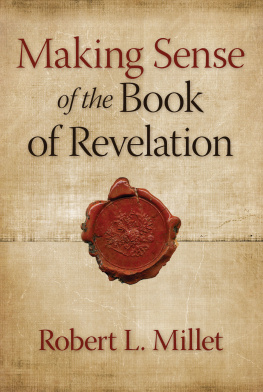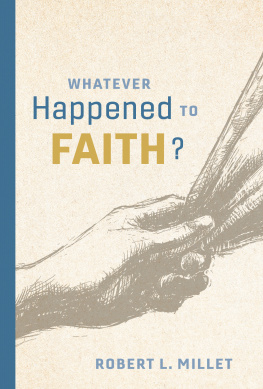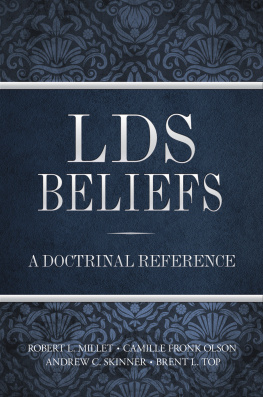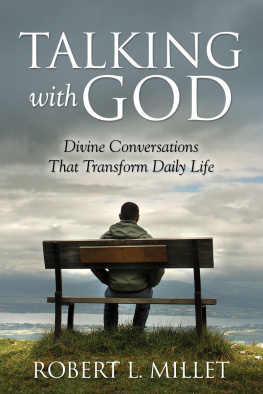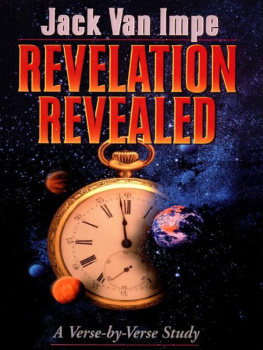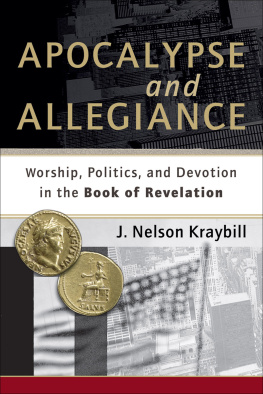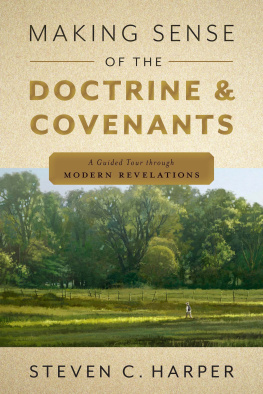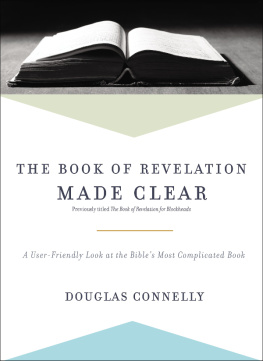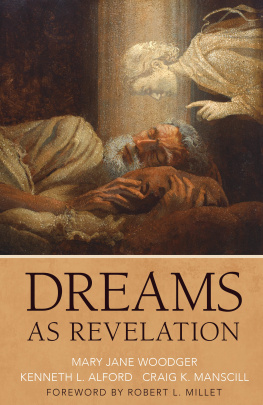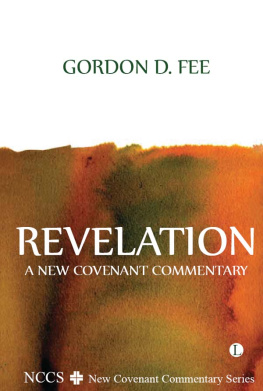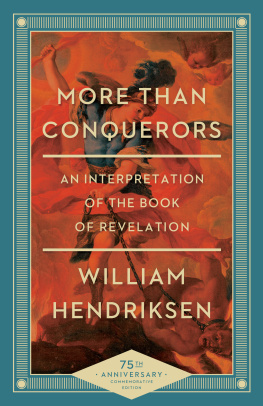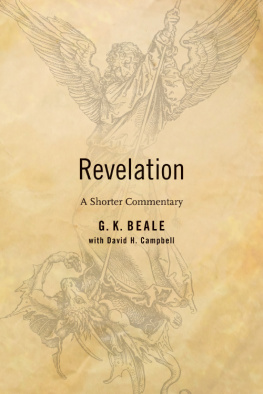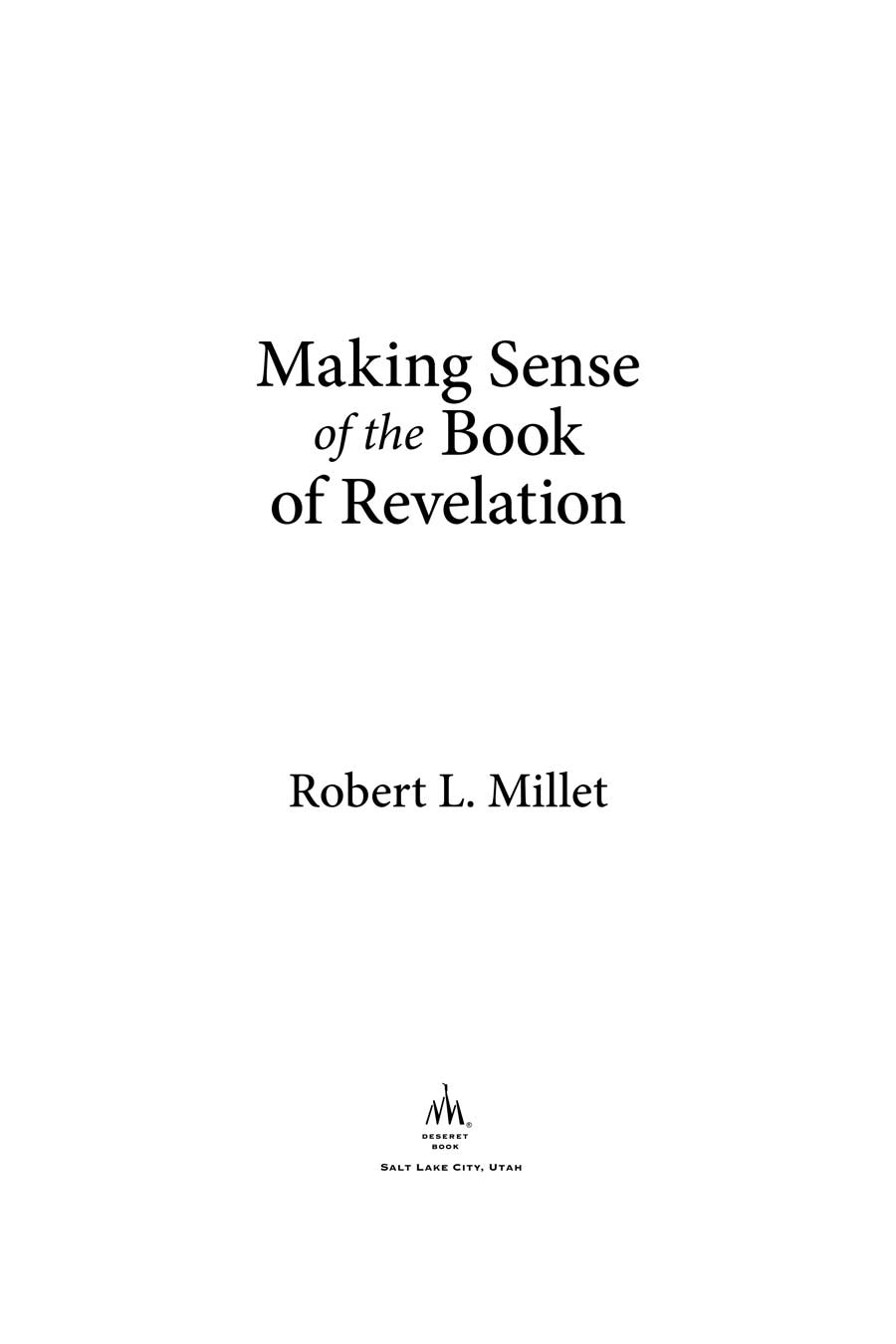2011 Robert L. Millet.
All rights reserved. No part of this book may be reproduced in any form or by any means without permission in writing from the publisher, Deseret Book Company, P.O. Box 30178, Salt Lake City Utah 30178. This work is not an official publication of The Church of Jesus Christ of Latter-day Saints. The views expressed herein are the responsibility of the author and do not necessarily represent the position of the Church or of Deseret Book. Deseret Book is a registered trademark of Deseret Book Company.
Library of Congress Cataloging-in-Publication Data
Millet, Robert L. author.
Making sense of the book of Revelation / Robert L. Millet.
pages cm
Includes bibliographical references and index.
ISBN 978-1-60641-944-1 (paperbound)
1. Bible. N.T. RevelationCriticism, interpretation, etc. 2. Eschatology. 3. The Church of Jesus Christ of Latter-day SaintsDoctrines. I. Title.
BS2825.52.M555 2011
228'.06dc22 2011007161
Printed in the United States of America
Worzalla Publishing Co., Stevens Point, WI
10 9 8 7 6 5 4 3 2 1
Other Books by Robert L. Millet
Are We There Yet?
Doctrinal Commentary on the Book of Mormon, 4 volumes with Brent L. Top and Joseph Fielding McConkie
Grace Works
Jesus, the Very Thought of Thee: Daily Reflections on the New Testament with Lloyd D. Newell
Men of Influence: The Potential of the Priesthood to Lift the World
Men of Valor: The Powerful Impact of a Righteous Man
Talking with God: Divine Conversations That Transform Daily Life
What Happened to the Cross?
When a Child Wanders
When Ye Shall Receive These Things with Lloyd D. Newell
Introduction
Making Sense of Johns Revelation
Perhaps no book of scripture has led to more speculation, spawned more foolishness, and resulted in more spiritual imbalance than the Apocalypsethe Revelation of John the Beloved. It was an important book in the first century of the Christian era, one that provided hope and perspective for the former-day Saints. And, when properly approached and understood, it provides a like hope for Latter-day Saints who live in the twenty-first century. Although it is not likely that even the most serious students of scripture will uncover every symbol and thereby come to understand every particular of the Revelation, there are certain doctrinal refrains, recurring lessons, and basic principles that may be grasped by all of us.
Background
The author of Revelation is John, the brother of James and son of Zebedee. This is the same John who served as an Apostle and a leader of the meridian Church and who wrote the Gospel of John and the three epistles. He is known variously as John the Beloved, John the Revelator, and the one Jesus loved (John 21:20). We know from the Book of Mormon (3 Nephi 28:67) and from modern revelation (D&C 7) that John was translatedchanged to a terrestrial state in which he would no longer be subject to the effects of the Fall, including physical suffering, bodily decay, and death. Like the three Nephites, he is still ministering among the people of the earth and will do so until the Second Coming of Jesus Christ, at which time he and they will be changed from mortality to immortality (3 Nephi 28:8, 2730). This book of scripture is called The Revelation of John, a servant of God, which was given unto him of Jesus Christ (JST, Revelation 1:1).
Though many modern biblical scholars are prone to cast doubt on the authorship of John the Beloved, his authorship has been attested from as early as the second century a.d. by Justin Martyr. The actual time of the writing is unknown, and debates continue among New Testament scholars. Some date the Apocalypse, a Greek work meaning revelation or unveiling, during the reign of the Roman emperor Domitian (a.d. 8196), while others propose a date some time during the reign of Vespasian (a.d. 6979). What we do know is that John wrote this book from the island of Patmos (see Revelation 1:9), a small volcanic island just southwest of Ephesus. The Revelation contains specific counsel, condemnation, warning, and prophetic promises to the seven churches of AsiaEphesus, Smyrna, Pergamos, Thyatira, Sardis, Philadelphia, and Laodiceabranches of the Christian Church that had been organized by the Apostle Paul during his missionary journeys.
Apocalyptic Literature
As most readers of Revelation can attest, reading this book is unlike any other experience in scripture. Whereas most of the Book of Mormon, for example, is given to us in plainness (2 Nephi 25:4; 31:3; 33:6), Revelation is not terribly plain to the generality of Saints. Johns messages are not always clear, and coming to understand what is intended often requires extensive cross-referencing, searching out historical details, and much pondering and discernment. It does not help that many plain and precious truths have been taken from the Bible (1 Nephi 13:2040), and specifically from Revelation.
Nephi was given a panoramic vision, a view of things from beginning to end (1 Nephi 1114). He was told, however, that he would not be permitted to write the whole of the vision in the Nephite record but that another, the Apostle John, would be asked to do so. Wherefore, the things which he shall write are just and true; and behold they are written in the book which thou beheld proceeding out of the mouth of the Jew; and at the time they proceeded out of the mouth of the Jew, or, at the time the book proceeded out of the mouth of the Jew, the things which were written were plain and pure, and most precious and easy to the understanding of all men (1 Nephi 14:2123).
Like Lehis dream or vision and in Nephis vision, Johns revelation was a Gods-eye view of things from eternity past to eternity future. John had the curtains of heaven withdrawn, the Prophet Joseph Smith explained, and by vision looked through the dark vista of future ages, and contemplated events that should transpire throughout every subsequent period of time, until the final winding up scene. time is not reckoned in the same way.
The following are additional elements and characteristics of apocalyptic writings (Revelation contains all of these):
1. Symbols. This literary genre is filled with symbolsobjects or messages that represent or typify other things. We find in Revelation such figures as lambs, dragons, candlesticks, stars, white stones, a sea of glass, animals filled with eyes and wings, books with seals, a bottomless pit, a huge cubic city, trumpets, vials with bitter potions, various-colored horses, white robes, seals on the forehead or right hand, locusts and scorpions, little books that are eaten, olive trees, a great whore, and a tree with twelve manner of fruits (Revelation 22:2). These all point to greater realities and deeper messages. They are symbols. In some cases we are able to uncover the symbolism through a careful reading of Revelation itself, but frequently we must turn to other revelation (particularly modern revelation) to uncover the meaning. And in some cases we are left without scriptural or prophetic commentary.
2. Beasts. There are many types of beasts in Revelation, and some of these are easier to understand than others. The Prophet Joseph Smith explained: It is not very essential for the elders to have knowledge in relation to the meaning of beasts, and heads and horns, and other figures made use of in the revelations....

